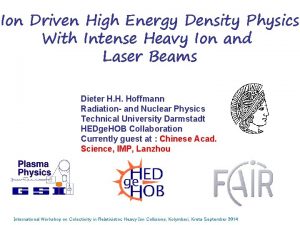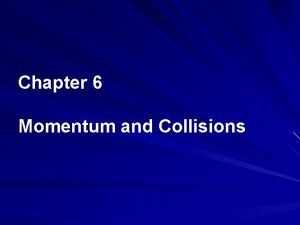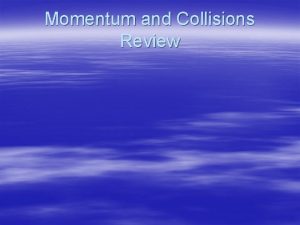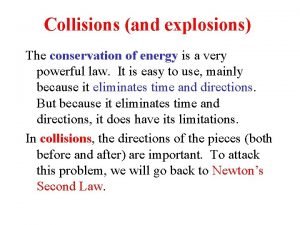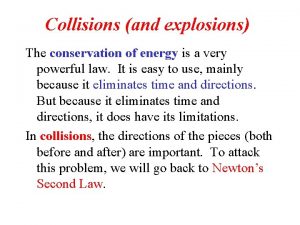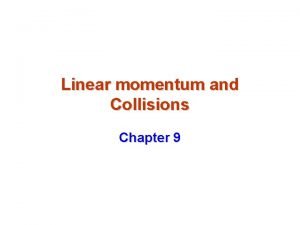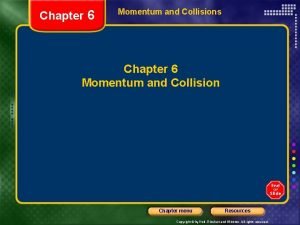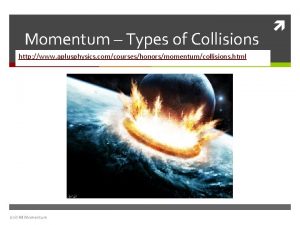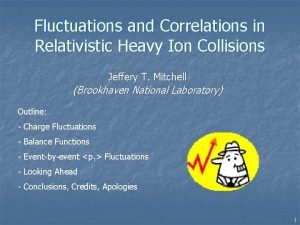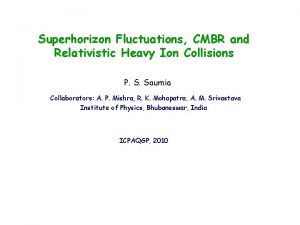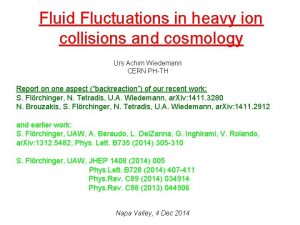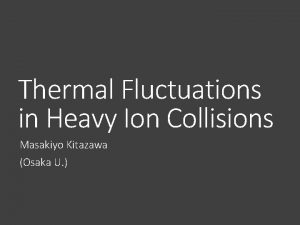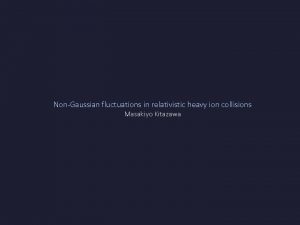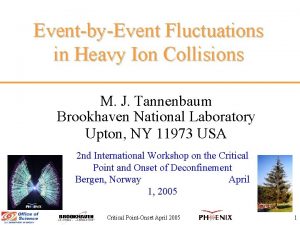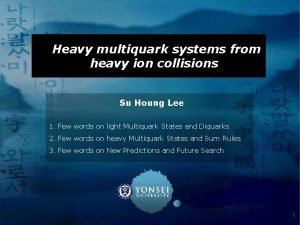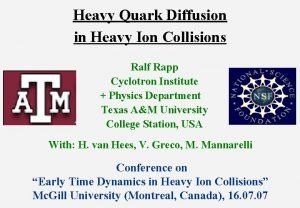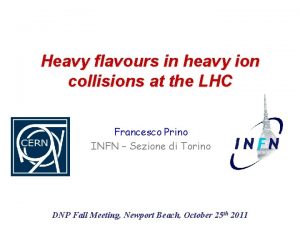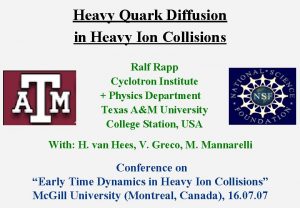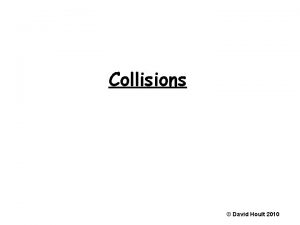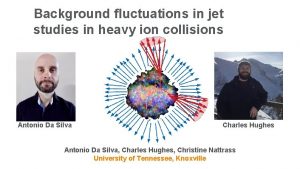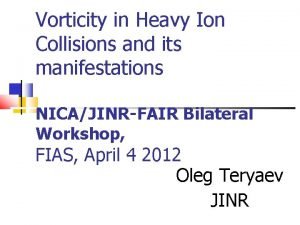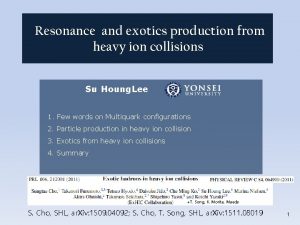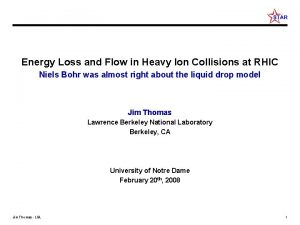Initial fluctuations and anisotropies in heavy ion collisions



















- Slides: 19

Initial fluctuations and anisotropies in heavy ion collisions Cyrille Marquet Centre de Physique Théorique École Polytechnique & CNRS based on: Albacete, Guerrero-Rodriguez, CM, JHEP 1901 (2019) 073 Giacalone, Guerrero-Rodriguez, Luzum, CM and Ollitrault, ar. Xiv: 1902. 07168

Outline • The fluid paradigm final-state momentum anisotropies from initial-state spatial anisotropies • Initial eccentricities from the Glasma how to calculate the initial spatial anisotropies: from the energy momentum tensor and its fluctuations • A new picture ab-initio description free from the Monte Carlo Glauber Ansatz

Flow in heavy-ion collisions

Two ingredients needed for flow is an initial spatial anisotropy turned into a momentum anisotropy by the hydrodynamic expansion of the medium final-state harmonic initial-state harmonic v 2 has two components: a geometric one and one due to fluctuations (the geometric component vanishes in central collisions) v 3 is only due to fluctuations

The eccentricity harmonics

Relevant averaged quantities • averaged quantities relevant for experiments: geometry + fluctuations geometry only fluctuations only • a 10 -year old prescription to compute ρ(s): - start with the ‘Glauber Monte Carlo Ansatz’ (sample nucleons according to the Woods-Saxon distribution) - propose some mechanism (more or less motivated by physics) to convert nucleons/partons into a smooth map of energy density (e. g. through interactions) instead, can we describe experimental data using the correlation functions of the primordial energy density as (only) input ?

Our strategy we follow Blaizot, Bronjowski, Ollitrault (2014) ~ ε 2{4} r. m. s. spatial anisotropy can be mapped to experimental data we need the 1 -point and 2 -point correlators

What is needed ? in particular the integral compute the 1 -point and 2 -point energy correlators

Initial eccentricities from the Glasma Albacete, Guerrero-Rodriguez, CM, JHEP 1901 (2019) 073

What is the Glasma ? the initial strong color field created after the collision 5. Individual hadrons freeze out 4. Hadron gas cooling with expansion 3. Quark Gluon Plasma thermalization, expansion 2. Pre-equilibrium state collision space-time picture of heavy-ion collisions Glasma 1. Nuclei (initial condition) CGC = Color Glass Condensate

The collision of two CGCs • the initial condition for the time evolution in heavy-ion collisions before the collision: r 1 r 2 the distributions of ρ contain the small-x evolution of the nuclear wave functions denotes the color charge which generates the field • after the collision the gluon field is a complicated function of the two classical color sources the field decays, once it is no longer strong (classical) a particle description is again appropriate

“strong-field” QCD factorization • solve Yang-Mills equations this is done numerically (it can be done analytically in the p+A case) • express observables in terms of the field determine , in general a non-linear function of the sources e. g. for this talk • perform the averages over the color charge densities we shall use the MV model for and each nucleus is characterized by its saturation scale

Relevant features of S(s 1, s 2) system size ~ 10 fm ~ 0. 1 fm scale of color neutrality ~ 1 fm

Results and data comparisons Giacalone, Guerrero-Rodriguez, Luzum, CM and Ollitrault, ar. Xiv: 1902. 07168

Comparison to MC Glauber models mean anisotropy rms ε 2 fluctuations rms ε 3 IP Glasma ~ MC Glauber, their fluctuations are dominated by the nucleon position sampling we only have fluctuations of the local color charge

Comparison to data - v 2{4} simply probes the average geometry, we use it to fix κ 2 - then, with a reasonable Qs value, we can reproduce the fluctuations in v 2{2} - the response coefficients are compatible with state-of-the-art hydro simulations - Qs(LHC) > Qs(RHIC) explains more eccentricity fluctuations at RHIC

Triangular flow we solve a long-standing problem of hydro-to-data comparisons: the ratio v 2{2} / v 3{2} grows quickly with centrality

Energy dependence fluctuations produce the splitting between the v 2{4} and v 2{2} data indicate that they are larger at RHIC energies Qs(LHC) ~ 1. 3 Ge. V Qs(RHIC) ~ 0. 8 Ge. V this is compatible with what we expect from QCD evolution towards high energies by contrast, MC Glauber-type calculations do not make any specific predictions for the v 2{4} / v 2{2} ratio

Conclusions ab-initio description free from the Monte Carlo Glauber Ansatz: • No random sampling of nucleons • No ad hoc prescriptions about the deposition of energy • Non perturbative physics only through the mass parameter
 Ratey algebra 2
Ratey algebra 2 Limitations of mti performance
Limitations of mti performance Measuring exposure to exchange rate fluctuations
Measuring exposure to exchange rate fluctuations Key facts about economic fluctuations
Key facts about economic fluctuations Measuring exposure to exchange rate fluctuations
Measuring exposure to exchange rate fluctuations Transaction exposure
Transaction exposure Heavy ion
Heavy ion Ion dipolo
Ion dipolo Dipolo dipolo inducido
Dipolo dipolo inducido Qué son las fuerzas intramoleculares
Qué son las fuerzas intramoleculares Induced dipole
Induced dipole A freight train is being assembled in a switching yard
A freight train is being assembled in a switching yard A 1850 kg luxury sedan stopped
A 1850 kg luxury sedan stopped Momentum and collisions review
Momentum and collisions review Inelastic collision examples
Inelastic collision examples Collisions and explosions
Collisions and explosions Collisions and explosions
Collisions and explosions Collision and its types
Collision and its types Chapter 6 momentum and collisions
Chapter 6 momentum and collisions Aplusphysics momentum-impulse answer key
Aplusphysics momentum-impulse answer key






